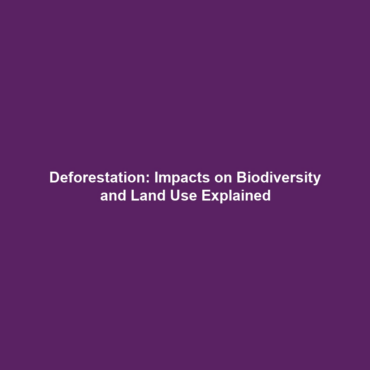Deforestation and Biodiversity Loss: An In-Depth Analysis
Introduction
Deforestation refers to the large-scale clearing of trees, often to make land available for agriculture, urbanization, or industrial activities. This widespread practice is a critical environmental concern as it directly contributes to biodiversity loss and disrupts ecosystems across the globe. Understanding the implications of deforestation is essential for fostering sustainable development and conservation efforts. As we delve deeper into the complex relationship between deforestation and biodiversity loss, it is vital to grasp how these issues intertwine and influence our planet.
Key Concepts
Understanding deforestation involves examining several key concepts that play a vital role in the broader conversation about biodiversity loss:
- Causes of Deforestation: Agricultural expansion, logging, and infrastructure development are primary drivers.
- Impact on Ecosystems: The removal of trees leads to habitat destruction, threatening wildlife and plant species.
- Climate Change: Deforestation contributes to increased carbon emissions, exacerbating global warming.
These concepts highlight how deforestation is not merely the removal of trees but a complex issue that threatens biodiversity and ecological balance. Recognizing the importance of addressing deforestation can lead to more informed policies targeting both biodiversity conservation and sustainable land use.
Applications and Real-World Uses
Deforestation has various applications, primarily relating to land utilization.
- Agricultural Development: Vast tracts of forested land are cleared to make way for crops and livestock.
- Urban Expansion: Urbanization necessitates land clearing for housing and infrastructure.
- Resource Extraction: Mining and logging operations often lead to deforestation, impacting surrounding ecosystems.
Understanding how deforestation is used in agriculture and urbanization helps us grapple with the balance between development and conservation.
Current Challenges
Addressing deforestation presents several challenges, which include:
- Economic Pressures: Economic growth often incentivizes forest clearing for agriculture and industry.
- Lack of Regulation: Inadequate enforcement of environmental laws facilitates illegal logging and land conversion.
- Sociopolitical Issues: Conflicts and governance issues can hinder conservation efforts.
These challenges of deforestation highlight the pressing need to develop comprehensive strategies that effectively address both economic and environmental concerns.
Future Research and Innovations
The future of addressing deforestation and biodiversity loss may involve innovative solutions and technologies, such as:
- Remote Sensing Technologies: Utilizing satellite imagery to monitor deforestation rates in real-time.
- Reforestation Initiatives: Advancements in genetic research may improve the success rates of planting indigenous trees.
- Agroforestry Practices: Combining agriculture and forestry can help mitigate the need to clear forests.
Continued research in these areas may significantly alter our approach to environmental preservation and resource management.
Conclusion
Deforestation poses significant risks to biodiversity and ecological integrity, impacting not only natural habitats but also human livelihoods. As we have explored, the intertwining issues surrounding deforestation and biodiversity loss necessitate urgent and concerted action. We encourage readers to delve deeper into this topic through additional resources and initiatives that promote sustainable land use and conservation. For further insights on environmental issues and their implications, visit our related topics.
